

Sharpen Your Workshop Routines: Setting up the Writer’s Notebook for a Year of Writing. Let’s have a conversation about sharpening workshop routines.
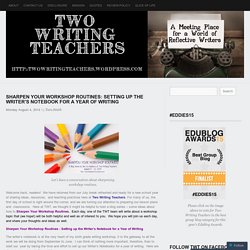
Welcome back, readers! We have returned from our July break refreshed and ready for a new school year of sharing ideas, resources, and teaching practices here at Two Writing Teachers. For many of us, the first day of school is right around the corner, and we are turning our attention to preparing our lesson plans and classrooms. Here at TWT, we thought it might be helpful to host a blog series – some ideas about how to Sharpen Your Workshop Routines.
Each day, one of the TWT team will write about a workshop topic that (we hope!) Sharpen Your Workshop Routines : Setting up the Writer’s Notebook for a Year of Writing The writer’s notebook is at the very heart of my sixth grade writing workshop, it is the gateway to all the work we will be doing from September to June. 1. 2. And keep our minilessons in the back: On average, each student will need two notebooks over the course of the school year. 3. 4. Writing Minilessons for Middle School to use... by Kasey Kiehl. CalkCurricPlan Gr6 ReadWshp. The 8 Minutes That Matter Most. I am an English teacher, so my ears perk up when writers talk about their process.

I've found the advice handy for lesson planning, too. That's because both writing and planning deal with craft. In writing, you want your audience to be absorbed. You want them to care about your characters. You want them be delighted by the suspense. John Irving, the author of The Cider House Rules, begins with his last sentence: I write the last line, and then I write the line before that. That is the crux of lesson planning right there -- endings and beginnings. The eight minutes that matter most are the beginning and endings. Here are eight ways to make those eight minutes magical.
Beginnings 1. YouTube reaches more 18- to 34-year-olds than any cable channel. 2. If you want to create a safe space for students to take risks, you won't get there with a pry bar. 3. Toss a football around the class before you teach the physics of a Peyton Manning spiral. Launching Your Readers Workshop. The key to a successful readers’ workshop is teaching your students the right procedures so that the workshop runs smoothly and effectively.
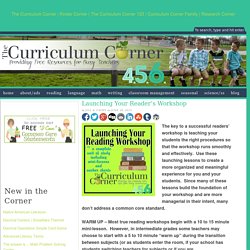
Use these launching lessons to create a more organized and meaningful experience for you and your students. Since many of these lessons build the foundation of your workshop and are more managerial in their intent, many don’t address a common core standard. WARM UP – Most true reading workshops begin with a 10 to 15 minute mini-lesson. However, in intermediate grades some teachers may choose to start with a 5 to 10 minute “warm up” during the transition between subjects (or as students enter the room, if your school has students switching teachers for subjects or if you are departmentalized).
The Reading & Writing Project - Running Records, Foundational Assessments and Benchmarks. The running record assessment forms provide a book introduction, the typed text, a sidebar of reading characteristics, a scoring guide, comprehension questions with sample responses, and space to take notes and to jot student responses.
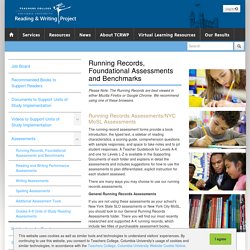
A Teacher Guidebook for Levels A-K and one for Levels L-Z is available in the Supporting Documents of each folder and explains in detail the assessments and includes suggestions for how to use the assessments to plan differentiated, explicit instruction for each student assessed. There are many ways you may choose to use our running records assessments. General Running Records Assessments If you are not using these assessments as your school’s New York State SLO assessments or New York City MoSL, you should look to our General Running Records Assessments folder. New York City Measures of Student Learning Assessments (MoSL) Please note, NYC MoSL information is current as of September 2018. New York State-approved Student Learning Objectives (SLO) Reading Minilessons to use for Middle School... by Kasey Kiehl.
The key to a successful Reading Workshop at the middle school level is allowing students enough time for their independent reading.
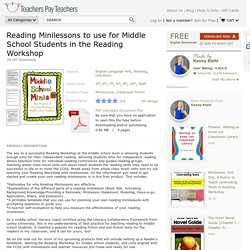
Allowing students time for independent reading allows teachers time for individual reading conferences and guided reading groups. Teaching whole class novel units will never teach students the reading skills they need to be successful in life or to meet the CCSS. Close Reading, Text Structures and Literature Circles. 5 Reasons to Use Mentor Texts With Big Kids - The Teacher Next Door - Creative Ideas From My Classroom To Yours. When I changed grade levels from second grade to 4th/5th, one of the things I really thought I would miss was all of my wonderful picture books.
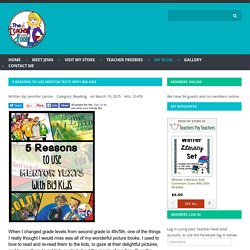
I used to love to read and re-read them to the kids, to gaze at their delightful pictures, and to use them to get kids excited about the magic of reading. Over the years, I loved picture books so much that if you saw my collection, you might have wanted to nominate me for some kind of teaching hoarder show (I had that many)! When we moved across the country and my new teaching job was 4th/5th (scared the dickens out of me at that time), I thought I would have to give up my picture books, pack them into boxes, and store them in my garage. But once I realized how effective they could be with my big kids, I happily unwrapped these picture book treasures and carted them off to school. Now, many of my picture books are key mentor texts...the stars of countless mini-lessons. 1. 2. I love the fact that mentor texts are short and sweet. ParentGuide ELA 6.
Mrs. Solomon's 6th Grade English Language Arts Class - My Blog. Mrs. Beers Language Arts Class.